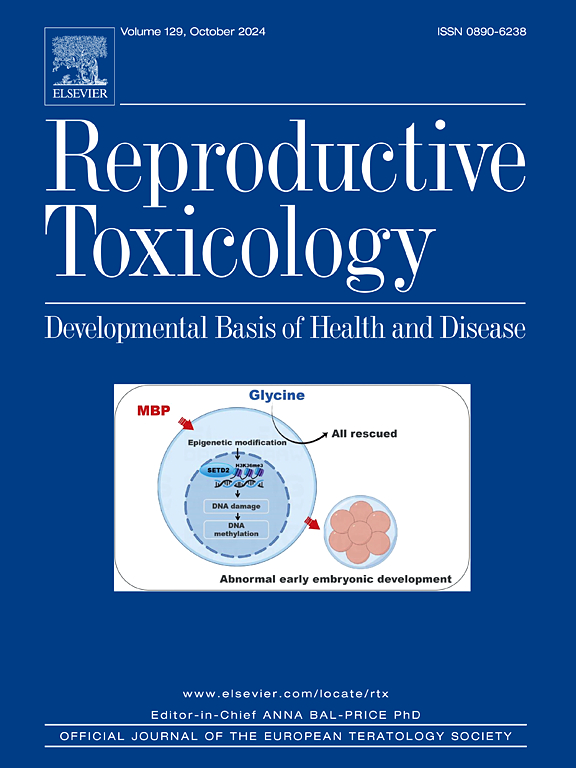Effects of 700 MHz radiofrequency radiation (5 G lower band) on the reproductive parameters of female Wistar rats
IF 2.8
4区 医学
Q2 REPRODUCTIVE BIOLOGY
引用次数: 0
Abstract
The advent of 5 G technology has raised concerns about its potential biological effects, particularly reproductive health being one key area of focus. This study investigated the impact of 700 MHz, a lower 5 G frequency band, on the reproductive health of female Wistar rats. The experiment analyzed the effects of short-term and long-term exposure to 700 MHz mobile radiation on female Wistar rats. Rats were divided into three groups (control, sham-exposed, and exposed), with sample sizes of n = 6 for short-term and n = 8 for long-term exposure. For short-term exposure, rats were subjected to 6 hrs of radiation daily for 10 days, while for long-term exposure, rats exposed 4 hrs daily for 60 days. Physiological parameters, including estrous cyclicity, were monitored, and histopathological and biochemical analyses were conducted on harvested ovaries. Comet assay was performed to assess DNA damage. The results indicated no changes in estrous cycles or comet assay parameters in either exposure group. Serological hormone levels, including estradiol and progesterone, remained within normal ranges, but a slight yet significant increase in testosterone levels was observed in exposed groups. Oxidative stress markers revealed elevated malondialdehyde (MDA) levels and significant decreases in superoxide dismutase (SOD), total sulfhydryl content, and ferric reducing antioxidant power (FRAP) in exposed ovaries. Histopathological analysis showed no significant changes in ovarian morphology in short-term exposure but revealed alterations, including cystic follicles and abnormal vasculature, in long-term exposure. These findings suggest that 700 MHz radiation may induce oxidative stress and tissue changes in ovarian samples over prolonged exposure.
700 MHz射频辐射(下5 G波段)对雌性Wistar大鼠生殖参数的影响
5 G技术的出现引起了人们对其潜在生物效应的关注,特别是生殖健康是一个关键的关注领域。本研究探讨了低5 G频段700 MHz对雌性Wistar大鼠生殖健康的影响。本实验分析了短期和长期暴露于700 MHz移动辐射对雌性Wistar大鼠的影响。大鼠分为三组(对照组、假暴露组和暴露组),短期暴露的样本量n = 6,长期暴露的样本量n = 8。短期暴露组大鼠每天接受6小时的辐射,持续10天;长期暴露组大鼠每天接受4小时的辐射,持续60天。对卵巢进行生理参数监测,包括动情周期,并进行组织病理学和生化分析。采用彗星法评估DNA损伤。结果表明,在两个暴露组中,发情周期或彗星测定参数没有变化。血清激素水平,包括雌二醇和黄体酮,保持在正常范围内,但在暴露组中观察到睾丸激素水平轻微但显着增加。氧化应激标志物显示,暴露的卵巢丙二醛(MDA)水平升高,超氧化物歧化酶(SOD)、总巯基含量和铁还原抗氧化能力(FRAP)显著降低。组织病理学分析显示,短期暴露后卵巢形态无明显变化,但长期暴露后卵巢形态发生改变,包括囊泡和血管异常。这些发现表明,700 MHz辐射可能在长时间暴露后诱导卵巢样品的氧化应激和组织变化。
本文章由计算机程序翻译,如有差异,请以英文原文为准。
求助全文
约1分钟内获得全文
求助全文
来源期刊

Reproductive toxicology
生物-毒理学
CiteScore
6.50
自引率
3.00%
发文量
131
审稿时长
45 days
期刊介绍:
Drawing from a large number of disciplines, Reproductive Toxicology publishes timely, original research on the influence of chemical and physical agents on reproduction. Written by and for obstetricians, pediatricians, embryologists, teratologists, geneticists, toxicologists, andrologists, and others interested in detecting potential reproductive hazards, the journal is a forum for communication among researchers and practitioners. Articles focus on the application of in vitro, animal and clinical research to the practice of clinical medicine.
All aspects of reproduction are within the scope of Reproductive Toxicology, including the formation and maturation of male and female gametes, sexual function, the events surrounding the fusion of gametes and the development of the fertilized ovum, nourishment and transport of the conceptus within the genital tract, implantation, embryogenesis, intrauterine growth, placentation and placental function, parturition, lactation and neonatal survival. Adverse reproductive effects in males will be considered as significant as adverse effects occurring in females. To provide a balanced presentation of approaches, equal emphasis will be given to clinical and animal or in vitro work. Typical end points that will be studied by contributors include infertility, sexual dysfunction, spontaneous abortion, malformations, abnormal histogenesis, stillbirth, intrauterine growth retardation, prematurity, behavioral abnormalities, and perinatal mortality.
 求助内容:
求助内容: 应助结果提醒方式:
应助结果提醒方式:


